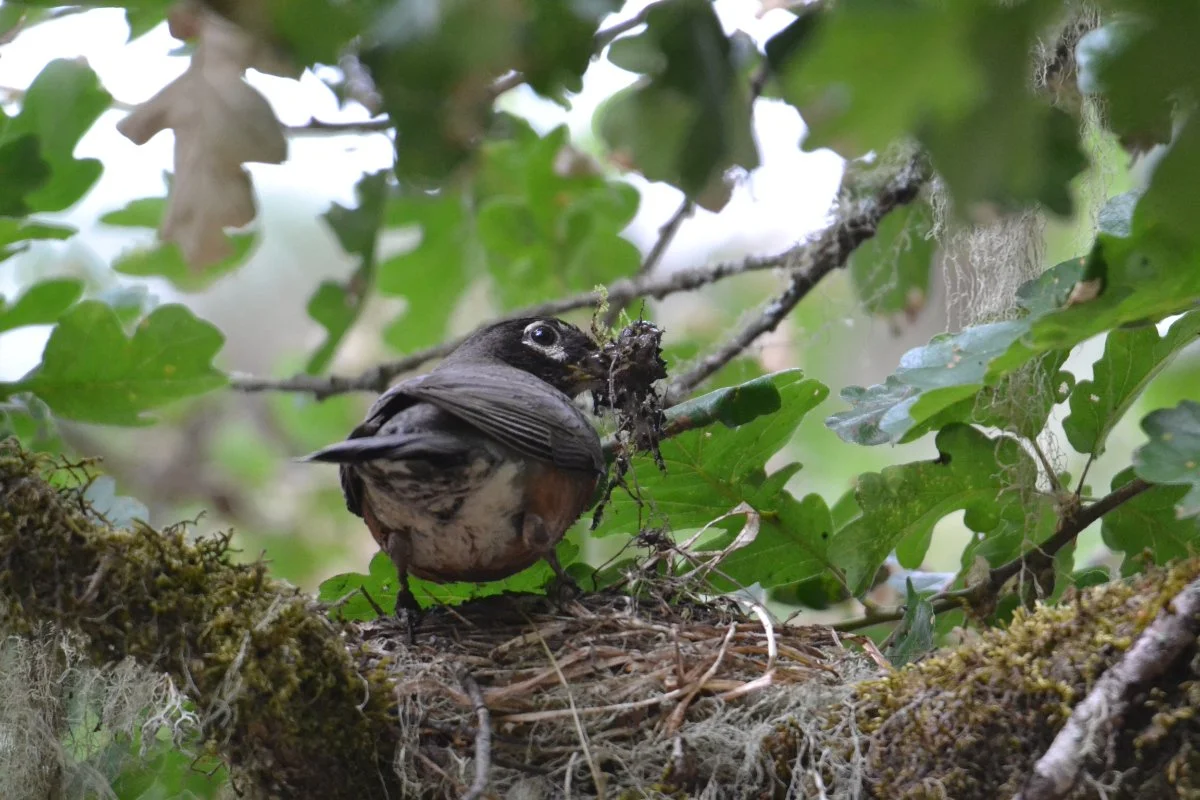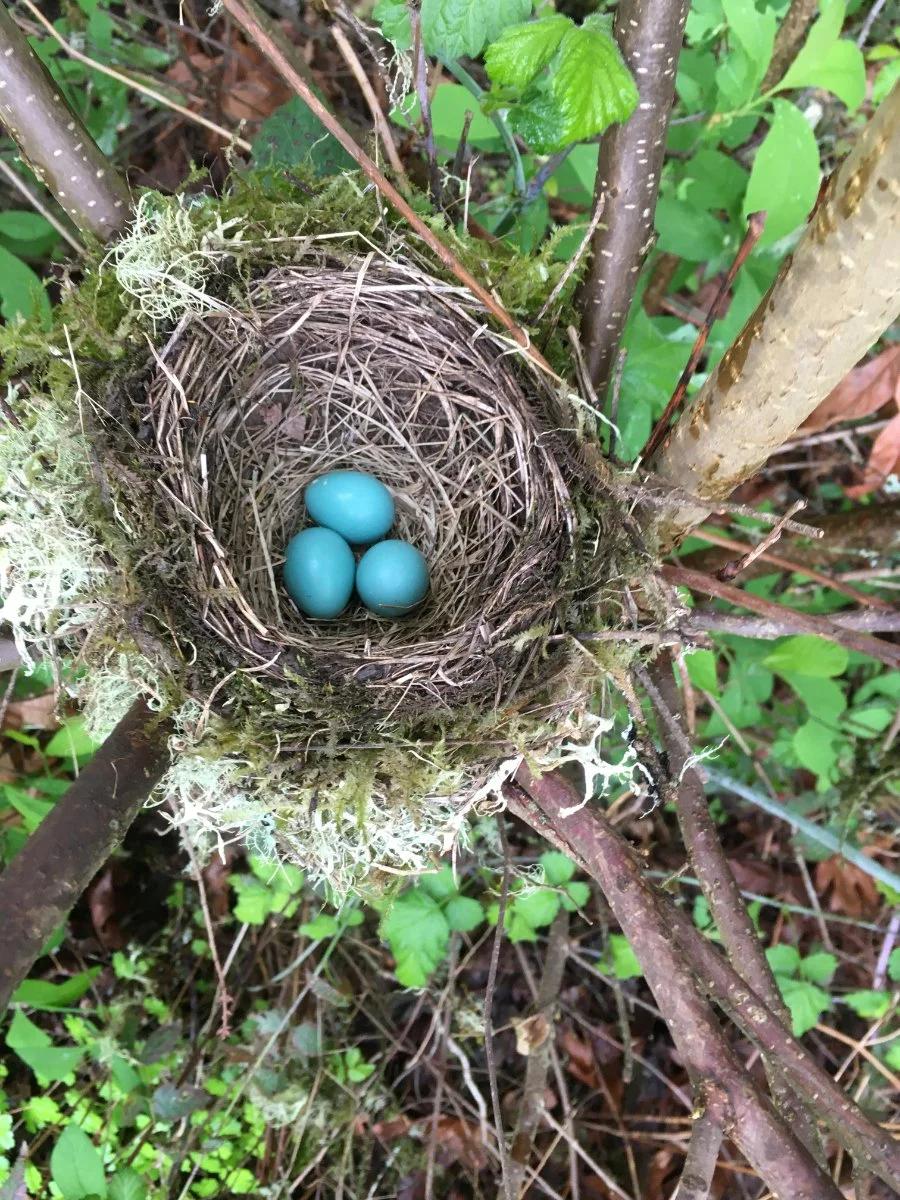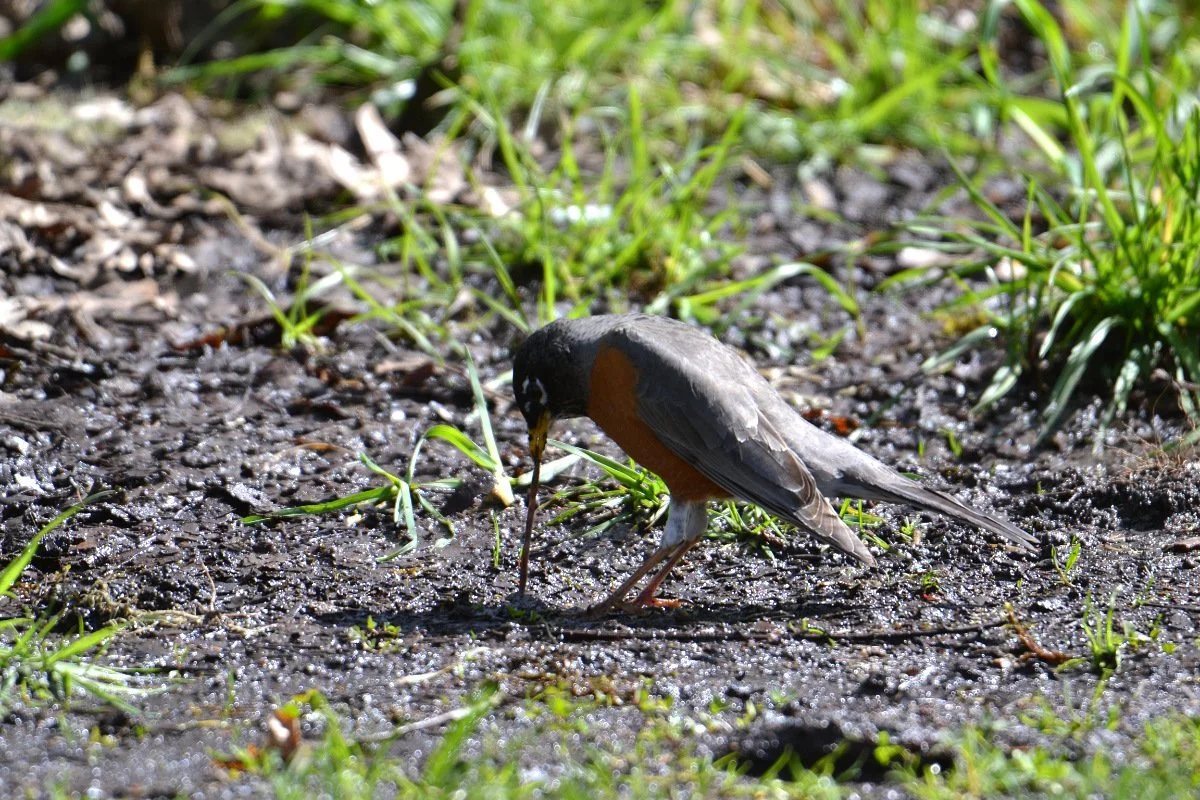American Robin (Turdus migratorius) Thrush Family
Robins are often seen on the lawn out in front of the White Oak pavilion. They have a recognizable feeding pattern of standing in an erect stance, looking and listening, giving a short run, pause, tilting head to look at the ground, and then snatching up a worm or insect. The adult male’s head and tail are blackish with a reddish-orange breast and underparts. They have a striped throat and a broken white eye ring. They have a white patch on the lower belly and under the tail. The colors on the female are duller. The juvenile has a rusty wash and a speckled breast.
Their sweet, caroling song is a familiar sound of spring. Cornell describes it as: “It’s a string of 10 or so clear whistles assembled from a few often-repeated syllables, and often described as cheerily, cheer up, cheer up, cheerily, cheer up. The syllables rise and fall in pitch but are delivered at a steady rhythm, with a pause before the bird begins singing again.”
Nest Building
Robins choose a variety of nest sites. Out at the arboretum, they often build on a sizable branch of an oak tree. I also see the nest built in the convergence of a number of branches that remind me of spokes in a basket that cradle the nest. Look at the photo of the eggs below for an example of this. They will also build on overlapping branches that make a horizontal platform for the nest. Out at the arboretum, the nest starts as a base that is constructed as a messy pile of lichen and grasses. From there, she will build a cup shape on top that mostly consists of grasses and small twigs. She will then collect beaks fulls of mud that is often mixed with a small amounts of other organic matter. This is pressed inside the cup to create a sturdy, long lasting nest. There is one still in a Douglas Fir out at the arboretum from 3 years ago. I saw a mourning dove use a one year-old robin’s nest last summer as a nest. You can see her collecting and pressing the mud into place with her body in the photos below.
Eggs & Babies
The eggs are a rich, sky blue and are about an inch long. The clutch size is usually 3-5 eggs.
Foraging
Robins have a varied diet. They are best known for hopping around on lawns looking for earthworms, especially in spring and summer. They also eat lots of fruit. Out at the arboretum, I see them eating fruits of the osoberry, madrone, red-osier dogwood, black hawthorn, dogwood (non-native), and Oregon grape. During the summer, I will often see them on the gravel bar on the river catching insects and flying off with a beak full to feed babies in the nest. Late this summer (2022), the last bird nest I found was a robin’s nest. Some of the blackberries were ripe, and I saw a parent collecting them and feeding them to the babies that were close to leaving the nest.
Behaviors
Head-scratching
A robin will scratch its head indirectly or overwing, which means that it always passes its leg over a drooped wing. As far as we know, all American Robins scratch their head in this way. The Birder’s Handbook says this about head-scratching: “As far as we can tell, it has several functions related to plumage maintenance. Since a preening bird cannot reach its head with its beak, scratching helps to spread preen oil there. Indeed, some species gather preen oil on the bill, scrape the bill with the foot, and then scratch the head. Head scratching may also remove molted feathers.” Most head-scratching is located near the ear and the essay in The Birder’s Handbook says: “It could be removing ectoparasites (those that live on the outside of the host) and their eggs, something that is done with the bill on other parts of the body.”
Sunning
This maintenance behavior seems to be associated with warmth, drying off, and parasites living on a bird’s skin or feathers. There is a good essay on The National Audubon’s website, Hot, Bothered, and Parasite-free: Why Birds Sun Themselves.
Attacking Reflection
During the breeding season, birds are territorial, especially the males. Over the last few years in the spring, I have observed a robin mistaking his reflection for another bird in his territory. It will sit on the sill and then fly up and bump against the window trying to fight off the intruder. You can see all of the stains from droppings on the window sill as an indication that it comes there often. In my opinion, this is causing unnecessary stress on the bird, especially during the breeding season in which they expend huge amounts of energy building a nest, protecting the nest, foraging, etc. It is best to get rid of the reflective quality of the glass. The Arboretum has done this using the Acopian Bird Savers on the windows of the White Oak Pavilion and this needs to be addressed on the bathroom windows as well.
Silhouette
To cap off the end of the book Peterson Field Guide to Birds of Western North America, Peterson included three panels of illustrations of the silhouettes of birds—shore, flight, and roadside. This is an important reference when determining what bird you’re watching because the lighting isn’t always ideal.
Quick Reference:
Height: 10”
Field Marks: Gray head & back, red breast, broken white eye ring
Habitat: Lawns, parks, farmland, many types of forests and woodlands.
Journal Location:
Mt. Pisgah Arboretum
Eugene, OR
References
American Robin Overview, All About Birds, Cornell Lab of Ornithology. https://www.allaboutbirds.org/guide/American_Robin/overview. Accessed 3 Sept. 2022.
Ehrlich, Paul R., et al. The Birder’s Handbook: A Field Guide to the Natural History of North American Birds: Including All Species That Regularly Breed North of Mexico. Simon & Schuster, 1988.
“Hot, Bothered, and Parasite-Free: Why Birds Sun Themselves.” Audubon, 27 Feb. 2020, https://www.audubon.org/news/hot-bothered-and-parasite-free-why-birds-sun-themselves.
Peterson, Roger Tory, et al. Peterson Field Guide to Birds of Western North America. 4th ed, Houghton Mifflin Harcourt, 2010.




































